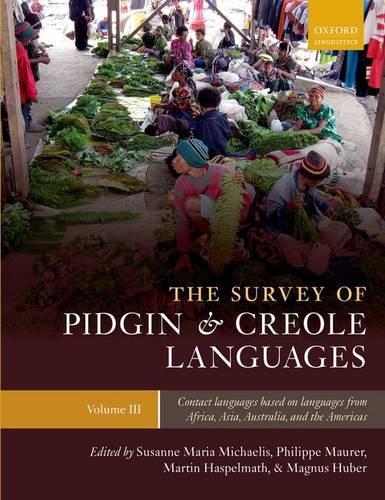Overview
The Atlas presents full colour maps of the distribution among the pidgins and creoles of 120 structural linguistic features drawn from their phonology, syntax, morphology, and lexicons. The languages include pidgins, creoles, and contact languages based on English, Dutch, Portuguese, Spanish, and French and languages from Africa, Asia, Australia, and the Americas. Each map is accompanied by a commentary. The project is the successor to the successful World Atlas of Language Structures and draws on the same linguistic, cartographic, and computing knowledge and skills of the Max Planck Institute for Evolutionary Anthropology in Leipzig. The Atlas is published alongside a three-volume Survey of Pidgins and Creoles which describes the histories and linguistic characteristics of 71 languages. The books have been designed, edited, and written by the world's leading experts in the field and represent the most systematic and comprehensive guide ever published to the world's pidgins, creoles and mixed languages. Individually and together the books are a unique resource of outstanding value for linguists of all persuasions throughout the world.
Full Product Details
Author: Susanne Maria Michaelis (, Max Planck Institute for Evolutionary Anthropology) ,
Philippe Maurer ,
Martin Haspelmath (, Max Planck Institute for Evolutionary Anthropology) ,
Magnus Huber (, Justus-Liebig-University Giessen)
Publisher: Oxford University Press
Imprint: Oxford University Press
Dimensions:
Width: 22.60cm
, Height: 2.00cm
, Length: 28.30cm
Weight: 0.836kg
ISBN: 9780199691425
ISBN 10: 0199691428
Pages: 208
Publication Date: 05 September 2013
Audience:
College/higher education
,
Postgraduate, Research & Scholarly
Format: Hardback
Publisher's Status: Active
Availability: To order

Stock availability from the supplier is unknown. We will order it for you and ship this item to you once it is received by us.
Reviews
[This set] will be an indispensable reference for anyone studying or working in this field; it is the only work of its type... Essential. --Choice
This set will be an indispensable reference for anyone studying or working in this field; it is the only work of its type... Essential. Choice [T]he Survey is a success. Claire Lefebvre, Studies in Language
Author Information
Susanne Maria Michaelis is is currently a creolist at the Max Planck Institute for Evolutionary Anthropology in Leipzig. Between 2008 and 2011, she held a researcher position in the APiCS project at the University of Gießen. Her early work focused on French-based Indian Ocean creoles, in particular Seychelles Creole (Temps et aspect en créole seychellois, 1993; Komplexe Syntax im Seychellen-Kreol, 1994). She is also editor of Roots of Creole Structures (Benjamins, 2008) and coeditor of the anthology Contact Languages: Critical concepts in linguistics (Routledge, 2008). Philippe Maurer is a creolist working on Ibero-Romance based creoles, mainly on Papiamentu (Les modifications temporelles et modales du verbe dans le papiamento de Curaçao, 1988) and on the Gulf of Guinea Creoles (L'angolar: un créole afro-portugais parlé à São Tomé, 1995, and Principense. Grammar, texts, and vocabulary, 2009. A book on the extinct Portuguese based Creole of Batavia and Tugu (Indonesia) will appear in 2011. Martin Haspelmath is senior scientist at the Max Planck Institut for Evolutionary Anthropology and Honorary Professor at the University of Leipzig. His research interests are primarily in the area of broadly comparative and diachronic morphosyntax (e.g. Indefinite Pronouns, OUP 1997) and in language contact (Loanwords in the World's Languages, co-edited with UriTadmor, de Gruyter 2009). He is co-editor with Matthew S. Dryer, David Gil, and Bernard Comrie, of The World Atlas of Language Structures (OUP 2005). Magnus Huber is Professor of English at the University of Giessen and an expert on English-based pidgins and creoles. He authored Ghanaian Pidgin English in its West African Context (Benjamins 1999), and edited Spreading the word. The issue of diffusion among the Atlantic Creoles (University of Westminster Press 1999) and Synchronic and diachronic perspectives on contact languages (Benjamins 2007). His research interests include world Englishes, historical sociolinguistics, dialectology, corpus linguistics, and historical linguistics.




